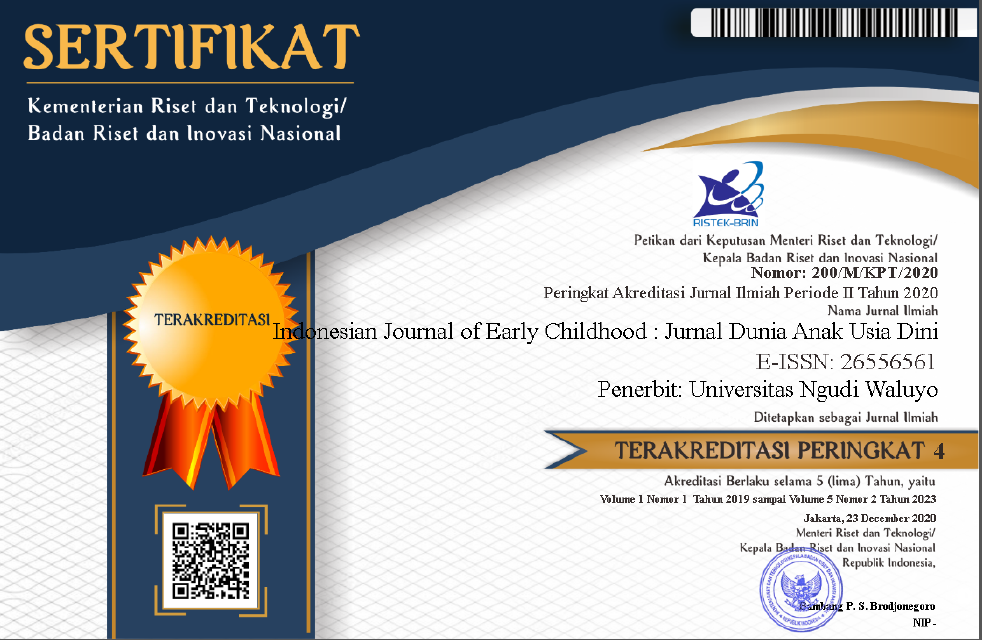Peningkatan Konsentrasi Anak Melalui Metode Eksperimen Membuat Balon Mengembang Tanpa Ditiup Pada Kelompok A1 TK HOM PIM PA
Improving Children's Concentration Through Experimental Methods of Making Balloons Expand Without Blowing Them in Group A1 of HOM PIM PA Kindergarten
DOI:
https://doi.org/10.35473/ijec.v7i1.2806Abstract
This research aims to increase children’s concentration through the experimental method of making balloons inflate without being blown up in group A1 at Kindergarten HOM PIM PA. The type of research chosen was Classroom Action Research (PTK) which was carried out in 2 cycles in group A1 at Kindergarten HOM PIM PA, totaling 19 people. Data collection techniques include observation, field notes and documentation. The results of the research showed that there was an increase in children’s concentration through the experimental method of making balloons inflate without being blown up. In the first cycle, the average percentage of children’s concentration ability was 52.63%. Then in the second cycle of action, the average percentage of children’s concentration ability was 84.21%. These results have an impact on increasing children’s concentration on the learning provided by the teacher.
ABSTRAK
Tujuan penelitian ini adalah untuk meningkatkan konsentrasi anak melalui metode eksperimen membuat balon mengembanga tanpa ditiup pada kelompok A1 di Tk HOM PIM PA. Jenis penelitian yang dipilih adalah Penelitian Tindakan Kelas (PTK) yang dilakukan sebanyak 2 siklus pada kelompok A1 di Tk HOM PIM PA yang berjumlah 19 orang. Teknik pengumpulan data meliputi observasi, catatan lapangan dan dokumentasi. Hasil penelitian menunjukan bahwa adanya peningkatan konsentrasi anak melalui metode eksperimen membuat balon mengembang tanpa ditiupyang dilakukan tindakan siklus I didapat presentase rata-rata kemampuan konsentrasi anak sebesar 52,63% . Kemudian pada tindakan siklus II didapat presentase rata-rata kemampuan konsentrasi anak sebesar 84,21%. Hasil ini berdampak pada meningkatnya konsentrasi anak pada pembelajaran yang diberikan oleh guru.
References
Anggreani, C. (2014). Peningkatan Kemampuan Berpikir Kritis Melalui Metode Eksperimen Berbasis Lingkungan. Jurnal Pendidikan Usia Dini, 9(2), 343–360. https://doi.org/10.21009/JPUD.092
Hemah, E., Sayekti, T., & Atikah, C. (2018). Meningkatkan Kemampuan Bahasa Anak Melalui Metode Bercerita Pada Anak Usia 5-6 Tahun. Jurnal Penelitian Dan Pengembangan Pendidikan Anak Usia Dini, 5(1), 1. https://doi.org/10.30870/jpppaud.v5i1.4675
Istiqomah, N., & Maemonah, M. (2021). Konsep Dasar Teori Perkembangan Kognitif Pada Anak Usia Dini Menurut Jean Piaget. Khazanah Pendidikan, 15(2), 151. https://doi.org/10.30595/jkp.v15i2.10974
Izza, H. (2020). Meningkatkan Perkembangan Sosial Anak Usia Dini melalui Metode Proyek. Jurnal Obsesi : Jurnal Pendidikan Anak Usia Dini, 4(2), 951. https://doi.org/10.31004/obsesi.v4i2.483
Khaeriyah, E., Saripudin, A., & Kartiyawati, R. (2018). Penerapan Metode Eksperimen Dalam Pembelajaran Sains Untuk Meningkatkan Kemampuan Kognitif Anak Usia Dini. AWLADY : Jurnal Pendidikan Anak, 4(2), 102. https://doi.org/10.24235/awlady.v4i2.3155
Khoiriyati, S., & Saripah, S. (2018). Pengaruh Media Sosial pada Perkembangan Kecerdasan Kognitif Anak Usia Dini. Aulada: Jurnal Pendidikan Dan Perkembangan Anak, 1(1), 49–60. https://doi.org/10.31538/aulada.v1i1.209
Khotimah, S. H., Sunaryati, T., & Suhartini, S. (2020). Penerapan Media Gambar Sebagai Upaya dalam Peningkatan Konsentrasi Belajar Anak Usia Dini. Jurnal Obsesi : Jurnal Pendidikan Anak Usia Dini, 5(1), 676. https://doi.org/10.31004/obsesi.v5i1.683
Manurung, M. P., & Simatupang, D. (2019). Meningkatkan Konsentrasi Anak Usia 5-6 Tahun Melalui Penggunaan Metode Bercerita di TK ST Theresia Binjai. Jurnal Usia Dini, 5(1), 65.
Novianti, R., Marega, D., & Wahyuni, D. (2022). Tebona: Permainan untuk melatih konsentrasi anak. Raudhatul Athfal: Jurnal Pendidikan Islam Anak Usia Dini, 6(1), 1–11. https://doi.org/10.19109/ra.v6i1.13292
Nurfuady, E., Hendriana, H., & Wulansuci, G. (2019). Penerapan Metode Eksperimen Untuk Meningkatkan Kreativitas Pada Anak Usia Dini. CERIA (Cerdas Energik Responsif Inovatif Adaptif), 2(3), 65. https://doi.org/10.22460/ceria.v2i3.p65-73
Pura, D. N., & Wulandari, A. (2020). Peningkatan Konsentrasi Anak Melalui Metode Eksperimen Membuat Lava Gunung Merapi. Early Childhood Research and Practice, 1(01), 22–27. https://doi.org/10.33258/ecrp.v1i01.1073
Ramadhanti, P. (2021). Peningkatan Kemampuan Berpikir Kritis melalui Pendekatan Saintifik pada Anak Usia 5-6 Tahun di RA Mutiara Ciputat. 121. https://bit.ly/3lFUrue
Downloads
Published
How to Cite
Issue
Section
License
Copyright (c) 2025 Indonesian Journal of Early Childhood: Jurnal Dunia Anak Usia Dini

This work is licensed under a Creative Commons Attribution-ShareAlike 4.0 International License.
Please find the rights and licenses in Indonesian Journal Of Early Childhood: Jurnal Dunia Anak Usia DIni. By submitting the article/manuscript of the article, the author(s) agree with this policy. No specific document sign-off is required.
1. License
The non-commercial use of the article will be governed by the Creative Commons Attribution license as currently displayed on Creative Commons Attribution-ShareAlike 4.0 International License.
2. Author(s)' Warranties
The author warrants that the article is original, written by stated author(s), has not been published before, contains no unlawful statements, does not infringe the rights of others, is subject to copyright that is vested exclusively in the author and free of any third party rights, and that any necessary written permissions to quote from other sources have been obtained by the author(s).
3. User Rights
Indonesian Journal Of Early Childhood: Jurnal Dunia Anak Usia Dini's spirit is to disseminate articles published are as free as possible. Under the Creative Commons license, Indonesian Journal Of Early Childhood: Jurnal Dunia Anak Usia Dini permits users to copy, distribute, display, and perform the work for non-commercial purposes only. Users will also need to attribute authors and Indonesian Journal Of Early Childhood: Jurnal Dunia Anak Usia Dini on distributing works in the journal and other media of publications.
4. Co-Authorship
If the article was jointly prepared by more than one author, any authors submitting the manuscript warrants that he/she has been authorized by all co-authors to be agreed on this copyright and license notice (agreement) on their behalf, and agrees to inform his/her co-authors of the terms of this policy. Indonesian Journal Of Early Childhood: Jurnal Dunia Anak Usia Dini will not be held liable for anything that may arise due to the author(s) internal dispute. Indonesian Journal Of Early Childhood: Jurnal Dunia Anak Usia Dini will only communicate with the corresponding author.
5. Miscellaneous
Indonesian Journal Of Early Childhood: Jurnal Dunia Anak Usia Dini will publish the article (or have it published) in the journal if the article’s editorial process is successfully completed. Indonesian Journal Of Early Childhood: Jurnal Dunia Anak Usia Dini's editors may modify the article to a style of punctuation, spelling, capitalization, referencing and usage that deems appropriate. The author acknowledges that the article may be published so that it will be publicly accessible and such access will be free of charge for the readers as mentioned in point 3.
Â
Every accepted manuscript should be accompanied by "Copyright Transfer Agreement" prior to the article publication.



